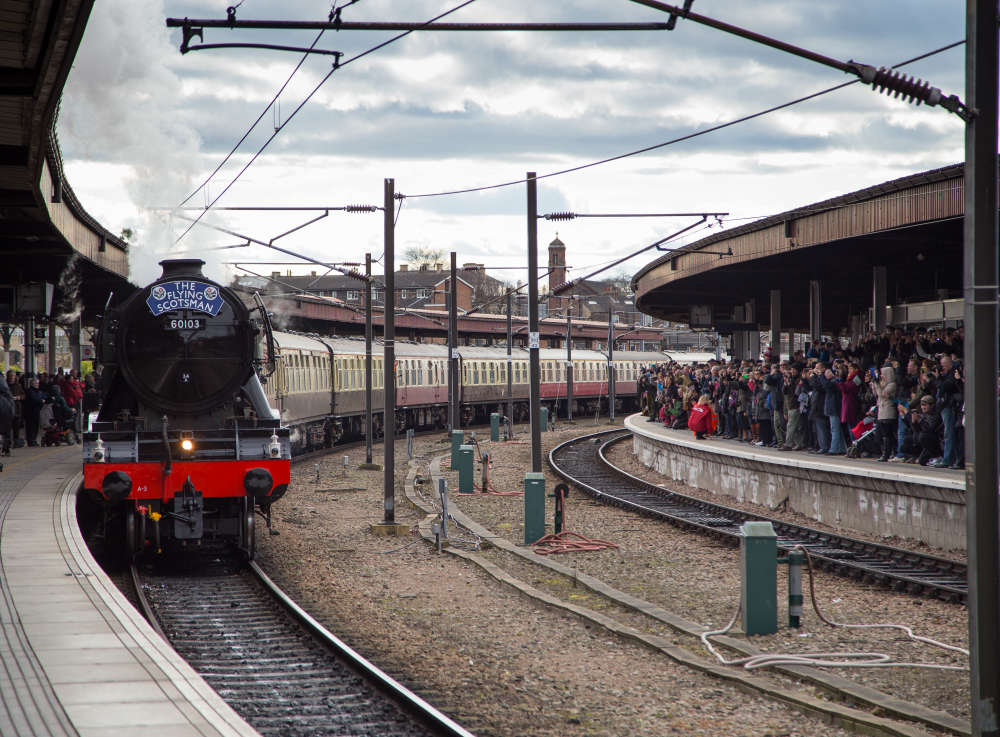
The most famous steam locomotive in the world – Flying Scotsman – will mark her centenary by making an emotional return to the city where she was built one hundred years ago.
Invited guests including civic dignitaries, historians and family members who share proud links with the famous locomotive will gather on the platform at Doncaster Station, which is directly opposite the old Doncaster Works where she was built.
There will be a short ceremony hosted by London North Eastern Railway (LNER) and City of Doncaster Council before she continues on her journey from Doncaster to York.
In 1923, Flying Scotsman was the first locomotive built by the then newly formed LNER which also celebrates its centenary this year.
In forty years of service, she broke numerous world speed and distance records. She became the first locomotive to officially break the 100mph barrier in 1934 and took part in races against other forms of transport to prove her speed.
Flying Scotsman became so famous that she travelled to the United States and Canada in the 1960s on promotional tours. She also became the first locomotive to circumnavigate the world when in 1988 she was shipped to Australia where she also set a new record for the longest non-stop run by a steam locomotive at 422 miles.
In a blaze of publicity, Flying Scotsman made her final journey for British Railways on 14 January 1963. For the next forty years ownership of Flying Scotsman changed several times. In 2004, a campaign spearheaded by the National Railway Museum (NRM) to save the locomotive for the nation amassed the support of thousands, confirming its status as a national treasure. The NRM is also supporting today’s event.
Flying Scotsman was just one of many famous locomotives introduced by LNER during its century of service on the East Coast Main Line connecting the capitals of England and Scotland. In 1938 Mallard set a world speed record for a locomotive by hitting 126mph and today LNER’s new Azuma Class can travel at 125mph.
Over the past century LNER has pushed boundaries to create ever greater feats of engineering, speed, comfort, customer service, while improving journeys between London to Scotland.
As well as Flying Scotsman, Doncaster Works built thousands of locomotives and carriages for over a century. It was the industrial centre of the city and at its peak in the early 20th century it covered over 200 acres and employed 4,600 workers.
Some carriage refurbishment work is still carried out on part of the site.
As part of the Centenary Weekender on Friday she will travel from London Kings Cross to York via the following stations:
- Stevenage
- Huntingdon
- Peterborough (briefly stopping)
- Grantham
- Newark
- Retford
- Doncaster (arriving around 1345 – stopping – departing at 1400)
- York - on Saturday she continues from York to Edinburgh
Full itinerary here - UK Steam Rail Day Trips and Worldwide Rail Holidays (railwaytouring.net)



 New Community Diagnostic Centre opens in York
New Community Diagnostic Centre opens in York
 York College Alumnus Lisa Parkinson receives BAFTA to add to collection of awards
York College Alumnus Lisa Parkinson receives BAFTA to add to collection of awards
 NHS booking system open for spring COVID-19 vaccinations
NHS booking system open for spring COVID-19 vaccinations
 Mass flowering is recorded at Yorkshire Wildlife Trust’s York Site
Mass flowering is recorded at Yorkshire Wildlife Trust’s York Site